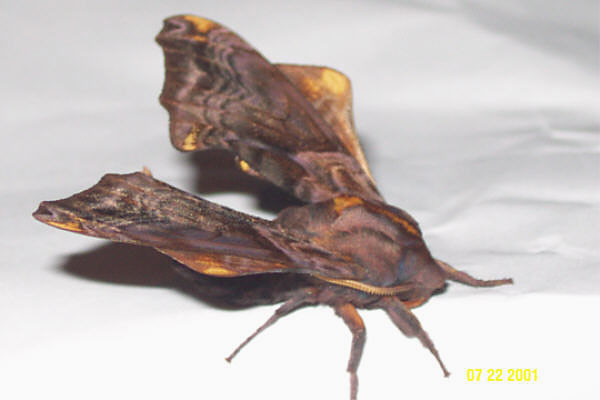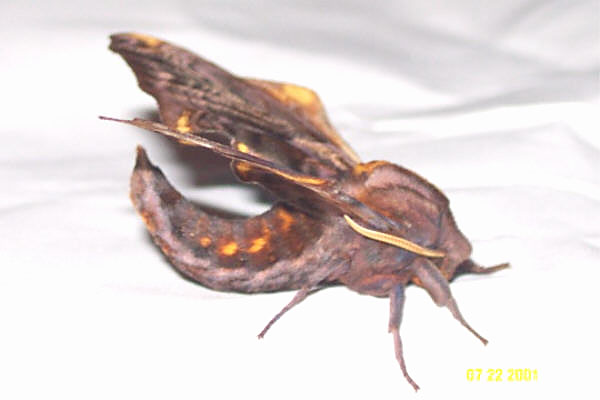Sphinginae subfamily
Sphingini tribe:
 |
Agrius cingulata,
USGS Pink-spotted hawkmoth,
stray
This moth is a very strong flier, but would only make its way to
Hamilton County as a rare stray.
|
 |
Ceratomia amyntor WO,
the Elm Sphinx or Four-horned Sphinx
This moth is not officially recorded in Hamilton, but I suspect it is
present.
Larvae feed on Elm (Ulmus), birch (Betula), basswood (Tilia), and
cherry (Prunus). |
 |
This species is not officially recorded for Hamilton.
It is recorded to
the north, east,
south and west, however. The larvae feed in large groups and are much more
spectacular than the moths. Catalpa is the larval host. |
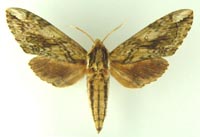 |
Ceratomia hageni
USGS,
Hagen's Sphinx or Osage Orange Sphinx
This species is officially recorded for Hamilton.
Larvae feed on osage orange (Maclura pomifera).
|
 |
This moth is not officialy recorded in Hamilton. It is recorded to
the north, east,
south and west, however.
It is
named for the wavy lines on the forewings. |
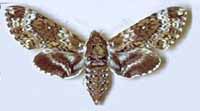 |
This moth is not officially recorded in Hamilton. It is
reported to the north, east, south and west, however.
|
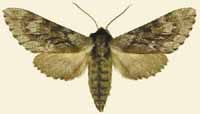 |
This moth is not reported from Hamilton County, but if you have pines, you
might have this species. It flies on P.E.I. unlikely
|
 |
This moth is not reported from Hamilton County, but it is
reported both to the northeast and southwest.
If you've got pines, this species is likely present. |
 |
Manduca jasminearum is not officially recorded in Hamilton County.
This species is officially recorded, however, in northern Kentucky, and it is likely present.
|
 |
This species is has not been officially recorded in Hamilton, but
if you grow tomatoes, you are likely to encounter it.
|
 |
This species is not officially recorded in Hamilton, but it has been
taken just to the south in Kentucky. I would not
be surprised to get a report. Look for three large yellow spots
on each side of the abdomen.
|
 |
This species is not officially recorded in Hamilton.
If you grow tomatoes, you have probably encountered it, though.
Larvae get very large and can strip a tomato plant.
|
 | The upperside of the forewing is gray with indistinct black and
white markings. There is a series of black dashes
from the base to the tip, and a small white cell spot.
|

|
Sphinx canadensis
WO,
Sphinx canadensis, the Canadian Sphinx, is not common, and is not
often reported anywhere,
but it might be present in Hamilton County as it is reported from Canada to
northern Tennessee.
Larval hosts are white ash (Fraxinus americana) and blueberry
(Vaccinium).
|
 |
Sphinx chersis WO,
the Northern Ash Sphinx or Great Ash Sphinx
This species is not officially reported in Hamilton. Larval hosts are ash,
lilac, privet, cherry, and quaking aspen.
|
 |
This species is not officially reported in Hamilton. We have them
on P.E.I., but I do not see them nearly as frequently
as I see the other Sphingidae. |
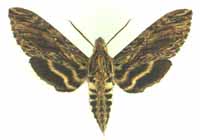 |
This species is not officially confirmed for Hamilton County.
Generally it is not widely reported.
Larval hosts are various species of beebalm (Monarda), mints (Mentha), bugleweed (Lycopis),
and sage (Salvia). |
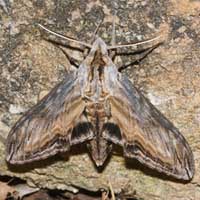 |
This species is not officially reported in Hamilton. Generally it
is not widely reported anywhere.
Similar to S. kalmiae
but lacks the dark bar
along the fw inner margin. unlikely |
 |
This species is not officially reported in Hamilton.
I have taken them on P.E.I., Canada, and reared them on
lilac. At rest the hindwings are usually completely covered.
|
Smerinthini Tribe:
 |
This moth is fairly widely reported to the north, east
south and west.
This is the first Sphinx species I reared as a boy in New Jersey.
See the file for the female; she is different. |
 |
Pachysphinx modesta
WO,
the Modest Sphinx or Poplar Sphinx
This moth is not officially recorded in Hamilton County. It is fond
of poplars and
willows.
They are common on Prince Edward Island. |
 |
This appears to be an uncommon species. They are not officially
recorded for Hamilton. unlikely
|
 |
Named for the dull grey-blue spot (minus dark pupil) in the hindwing,
this moth has a wide distribution and is common in Hamilton
County.
I regularly see them on Prince Edward Island, and they are reported
as far south as Florida. |
 |
Named for the small eye-spot in the hindwing, this moth has a wide distribution
and is probably common in Hamilton County.
I regularly see them on Prince Edward Island, and they are reported
as far south as Florida.
|
Paonias myops, July 22, 2001, Cincinnati, Lynn Goff.
 |
This moth is widely distributed and fairly common.
Along the East Coast, it flies from P.E.I. to Florida, with many reports from Kentucky and Michigan. |
Macroglossinae subfamily
Dilophonotini tribe:
 |
This species is not reported in Hamilton, but it might make an appearance as a rare
stray.
Males and females differ.
|
 |
Hemaris thysbe
WO, the Hummingbird Clearwing
This interesting day flier is not confirmed in Hamilton, but
is widely reported to the north, east and west.
They are widely distributed in the east from P.E.I. to Florida, from Alabama to Michigan. |
 |
Hemaris diffinis
WO, the
Snowberry Clearwing or Bumblebee Moth
This moth is widespread, but it has not been officially recorded in
Hamilton. It has been confirmed in nearby counties and states.
|
Philampelini tribe:
 |
This moth is not officially reported for Hamilton, but
has been reported to north, east, south and west.
Note the differences between this moth and the Pandorus Sphinx. |
 |
This moth is not officially reported for Hamilton, however,
the moth is a strong flier and
occasionally moths and larvae turn up as very rare strays in northern
communities.
|
 |
If you have Grape or Virginia Creeper nearby, then you probably have
this species.
I often get reports of larvae from outside the reported range. |
Macroglossini tribe:
 |
This day flier is widely distributed. If you have Virginia Creeper, you
probably have the Nessus Sphinx. It is reported from
Richmond.
Two bright, distinct, narrow yellow
bands are often visible on the abdomen.
|
 |
They are common in New Jersey and common
here on Prince Edward Island, and they are probably common in Hamilton Co..
You will often see this species listed as Darapsa pholus,
especially in older literature.
|
 |
Darapsa myron
WO, the Virginia Creeper Sphinx or the Grapevine Sphinx
This moth is not recorded on the U.S.G.S. site for Hamilton County,
but I strongly suspect its presence.
If you have the
foodplants indicated in the common names, you probably have this
species nearby. |
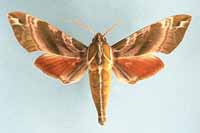 |
If you have hydrangea growing near a stream, then you may have the
Hydrangea Sphinx.
It has not been reported in Hamilton County,
but I suspect it is present, but probably uncommon. unlikely
|
 |
This species has not been officially recorded in Hamilton.
Grape (Vitis), ampelopsis (Ampelopsis), and Virginia creeper (Parthenocissus) all serve as larval hosts. |
 |
Hyles lineata
WO, the White-lined Sphinx
This species has
strong migrating tendancies from much further south.
There are records from New Hampshire, Maine, Michigan, Illinois, etc. |
 |
This moth is very much under reported across the United States. It
is a rapid day flier so is probably not in too many collections.
Grape is a popular larval host. I have taken it is Pottersville.
|
 |
This moth is much more common to the south. It is a strong migrant,
however. It may stray to Hamilton County.
|
|
|
